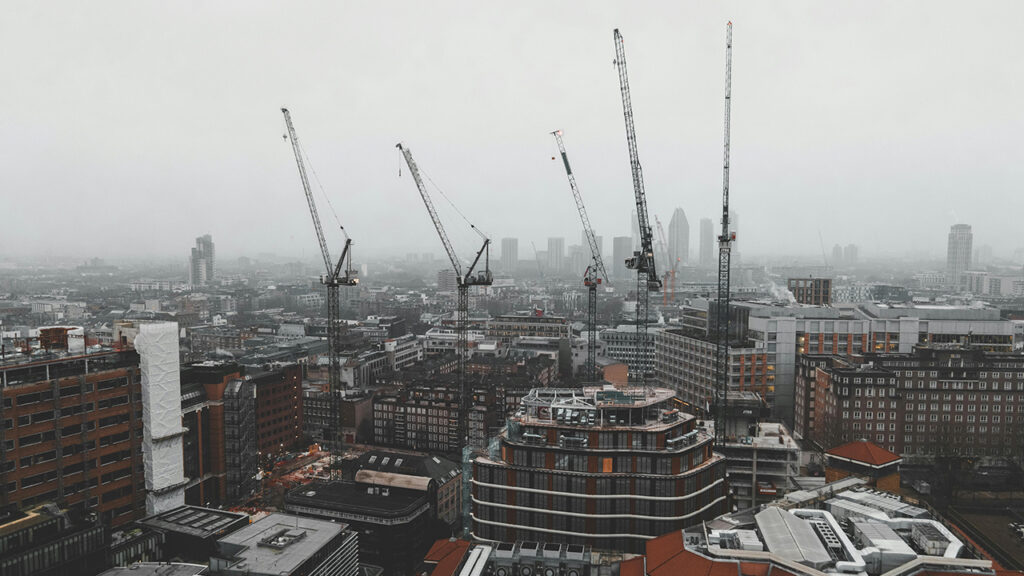
Black carbon in Central London: Focus shifts to construction after reductions in vehicle emissions
Black carbon levels in London’s air have fallen significantly – thanks in part to policies like the Ultra Low Emission Zone – but construction activity is now emerging as a dominant source of black carbon emissions in the city centre.
Air quality researchers used pollution monitoring equipment mounted on the BT Tower in central London to collect real-world insight into the sources of this type of air pollutant. Data collected during summer and winter reveal surprising contributions to London’s black carbon air pollution levels, beyond road traffic.
Black carbon
Black carbon is soot from combustion and is a component of PM2.5, which refers to particulate matter with a diameter of 2.5 micrometres or less. These are very fine particles that can enter the lungs and bloodstream, and are known to have both short-term and long-term effects on human health.
The latest World Health Organisation air quality guidelines report in 2021 recommended that black carbon is routinely monitored in addition to PM2.5 because combustion emissions are thought to be especially harmful.
BT Tower atmospheric observatory
At 190 metres tall, the BT Tower observatory filters and analyses air as it moves upwards from the streets and buildings below. A gas inlet mast on top of the tower pumps air into the 35th floor laboratory, collecting pollution from the nearby region that is dominated by roads, commercial residential buildings, construction sites, and some urban parkland.
Construction emissions of black carbon
This study found that emissions from non-road mobile machinery, including generators and heavy machinery used on building sites, can surpass the black carbon emissions from vehicles. This is particularly clear for areas with dense construction.
The scientists also conducted a detailed spatial footprint analysis to pinpoint emission hotspots that were directly linked to active construction sites near the measurement location.
“We found only minimal emissions from traffic, which is consistent with emissions reductions associated with Euro 6, the standard for diesel engines specified by ULEZ. This is in contrast to previous measurements in London, collected in 2012, which showed a strong association between traffic and black carbon. At the time, diesel particle filters had only been introduced relatively recently. And while domestic wood burning is also known to be a source of black carbon in the UK, this was predictably not found to be the case in central London which is mainly commercial rather than residential,” explains Dr James Allan, senior research scientist at the National Centre for Atmospheric Science and University of Manchester.
Implications for air quality research and policy
The Ultra Low Emission Zone in London, and stricter vehicle emission standards, have led to marked improvements in urban air quality. Dr James Allan outlines how the research findings indicate that similar regulatory attention is now needed for the construction sector.
“We compared observed emissions with emission standards for construction equipment and found that even with compliance, black carbon output from generators, machinery and construction vehicles remains significant. Our work highlights how measurement techniques like eddy covariance can fill critical gaps in our understanding of urban pollution and support evidence-based strategies to protect public health and the environment” says Dr James Allan.
Eddy covariance works by measuring the turbulent motion of air, also known as eddies, and the concentration of airborne substances like black carbon within those eddies.
This study identifies the need to improve emission factor estimates for construction machinery, and may inform regulations for non-road mobile machinery emissions and overall London air quality improvements.
Read Quantifying black carbon emissions from traffic and construction in central London using eddy covariance, now published in Environmental Science: Atmospheres.
Acknowledgements
The research team involved scientists from the University of Manchester, UK Centre for Ecology and Hydrology, University of York, Zhejiang University, and the National Centre for Atmospheric Science.
The BT Tower observations were part of a series of measurements monitoring emissions in central London as part of the OSCA project, funded by the UK Research and Innovation’s Clean Air Programme.
The BT Tower black carbon measurements in London follow on from similar methods performed in Beijing and Delhi, which were part of the Atmospheric Pollution and Human Health programme funded by the Natural Environment Research Council.
